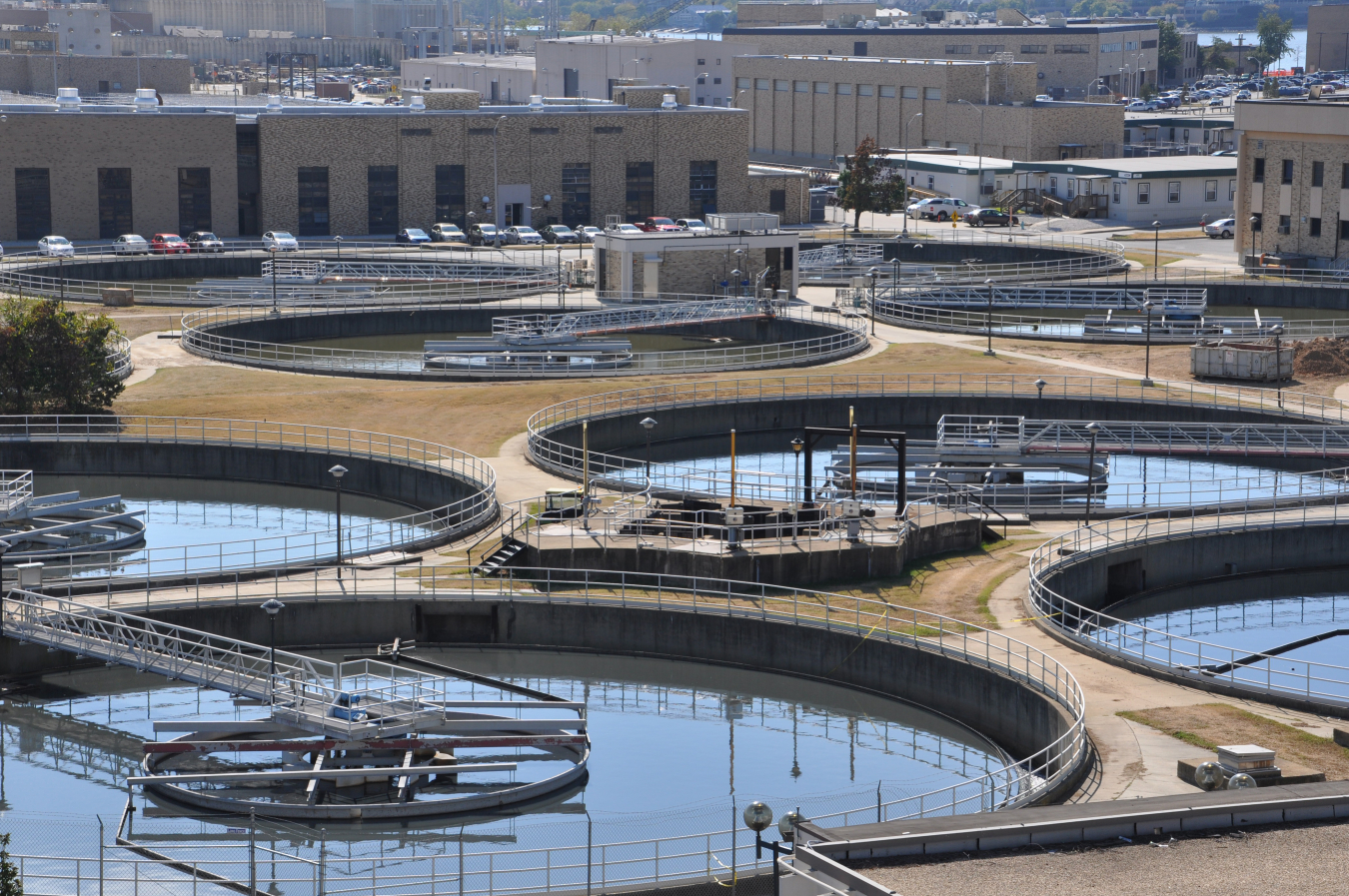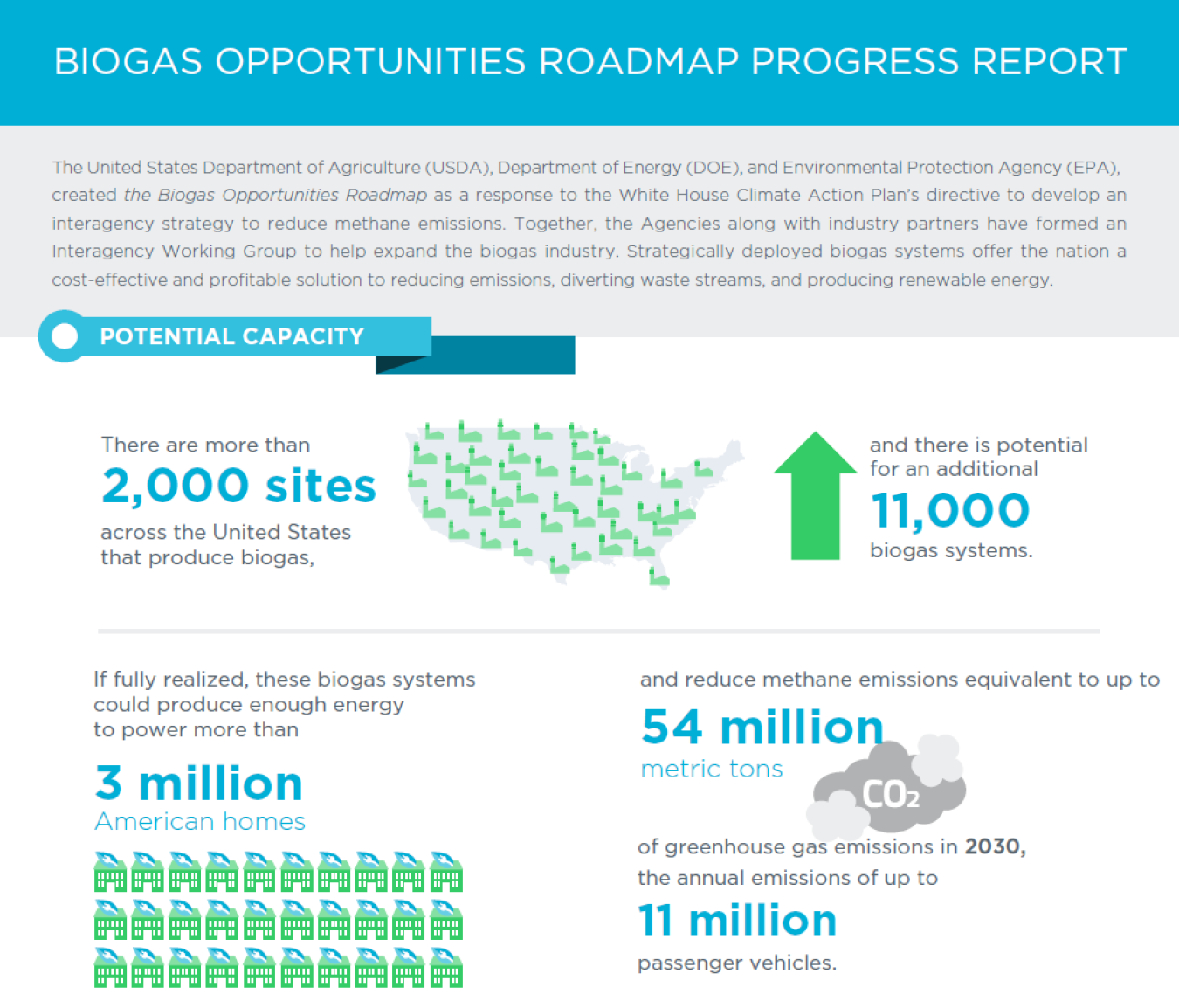Over the past year, the Energy Department, EPA, and USDA have worked collaboratively and with the private sector to develop the biogas industry.
Office of Critical Minerals and Energy Innovation
December 18, 2015Newtown Creek Wastewater Treatment Plant | New York City Department of Environmental Protection

DC Water’s Blue Plains Advanced Wastewater Treatment Plant | DC water
Methane is both a powerful energy source and a potent greenhouse gas. When it’s extracted from the earth as natural gas and burned for heating and electricity, it emits carbon dioxide (CO2) but burns more cleanly than some other energy sources such as coal. However, when methane escapes into the atmosphere, it traps 25 times more heat radiation than CO2. That’s why some people are concerned with the environmental consequences of methane leaks during the process of fracking.
But how about methane leaks from landfills and cow manure? Both of these sources release methane, too—28% of total methane emissions in the United States come from manure management and landfills, compared to 29% from natural gas and petroleum systems. Manure and landfill methane—referred to as “biogas”—can be captured with a large tank called a biogas digester. Once contained, biogas can be converted to electricity and heat, just like natural gas. Biogas is not a fossil fuel, so it doesn’t increase the levels of carbon in the atmosphere.

An snapshot of the Biogas Opportunities Roadmap Progress Report
As a follow-up to the President’s Climate Action Plan, last year, the Energy Department, U.S. Environmental Protection Agency (EPA), and U.S. Department of Agriculture (USDA) teamed together to create the Climate Action Plan Strategy to Reduce Methane Emissions. This plan charted a path forward for reducing methane emissions overall. Then, the Biogas Opportunities Roadmap, released several months later, determined specific actions for the agencies to take to help turn landfill and agriculture-related methane “leaks” into a useful energy resource like natural gas.
“The Office of Energy Efficiency and Renewable Energy's bioenergy, fuel cells, and vehicles offices are pleased to contribute to this interagency collaboration to expand the beneficial uses of biogas, thereby producing valuable biofuels, bioproducts, and biopower, and reducing greenhouse gas emissions,” said David Danielson, DOE Assistant Secretary for Energy Efficiency and Renewable Energy.
One year later, we’re well on our way to developing these biogas opportunities. The Energy Department, EPA, and USDA released the Biogas Opportunities Roadmap Progress Report to assess the progress, including these achievements:
1. Policy and Program Updates
The Energy Department’s Bioenergy Technologies Office increased its research emphasis on biogas by incorporating wet waste (a source of biogas) as a feedstock in its multi-year program plan. EPA included biofuel produced from biogas in the Renewable Fuel Standard. USDA developed a streamlined application and new scoring criteria for anaerobic digesters in its Rural Energy for America Program and made biogas projects eligible for its loan guarantee programs. USDA also made changes to coordinate its programs to provide the maximum potential assistance to producers interested in getting an anaerobic digester for their farming operations.
2. Research and Development Efforts
The Energy Department, USDA, and EPA each offer funding for development of biogas technologies. The Energy Department is currently funding several biogas projects. At the National Renewable Energy Laboratory, scientists are using microorganisms to convert the methane in biogas to muconic acid, a key building block for producing biofuel and bioproducts. A second project, with Natureworks, LLC, is developing the fermentation of biogas to produce lactic acid—which can also be used in biofuels and bioproducts. At Argonne National Laboratory, scientists succeeded in developing an anaerobic digestion process, which produces biogas from sludge at wastewater treatment plants. Argonne National Laboratory also expanded its Greenhouse Gases, Regulated Emissions, and Energy use in Transportation (GREET) Model to include calculations of the benefits of natural gas from landfill gas, manure-based anaerobic digesters, and wastewater treatment plants as compared with natural gas or petroleum.
3. Technology Advances
Funding from DOE, EPA, and USDA, have already contributed to biogas technology advances. The Fountain Valley Energy Station in in Orange County, California, was co-funded by the Energy Department and became the world’s first tri-generation hydrogen energy and electrical power station, which can co-produce hydrogen from biogas in addition to electricity and heat. The Energy Department’s Fuel Cell Technologies Office funded a project to demonstrate production of hydrogen from landfill gas to operate material handling equipment powered by fuel cells at a nearby BMW manufacturing plant in Greer, South Carolina. The Energy Department’s Clean Cities program and Argonne National Laboratory are developing a database of existing and planned projects that produce renewable natural gas for vehicle fuel or pipeline injection, as well as a toolkit to assist coordinators in communicating the benefits of renewable natural gas.
Over the past year, the Energy Department, EPA, and USDA have worked collaboratively and with the private sector on these projects to develop the biogas industry and to connect stakeholders with available resources. With last year’s roadmap, the agencies have identified more than 2,000 sites across the United States that produce biogas as well as the potential for an additional 11,000 biogas systems.
The agencies are continuing to seek ways to integrate biogas activities into broader strategies and meet goals for reduced greenhouse gas emissions, increased diversion of wastes, and greater energy independence. Read more details about our progress in the Biogas Opportunities Roadmap Progress Report.
Valerie Sarisky-Reed

Valerie Sarisky-Reed is the director of the Bioenergy Technologies Office (BETO) in the Office of Critical Minerals and Energy Innovation (CMEI). In this role, she manages efforts to improve performance, lower costs, and accelerate market entry of bioenergy technologies. She assists in overseeing strategic planning to meet aggressive goals covered by the BETO research and development budget of approximately $250M annually, working with the U.S. Department of Energy's (DOE) national laboratories, academia, and industry.
Sarisky-Reed has more than 30 years of experience in addressing energy and environmental topics faced by the United States and globally. In addition to her programmatic activities, she is a founding member of the Metabolic Engineering Working Group, chartered by the Biotechnology Research Subcommittee, an inter-agency coordinating committee under the Office of Science and Technology Policy.
She also spent two years serving the chief scientist at the U.S. Department of Agriculture, helping to build bridges between DOE and the U.S. Department of Agriculture in support of the bioeconomy. As acting director for EERE's Wind Energy Technologies Office, she enabled the development of the most recent Multi-Year Program Plan, which focused heavily on bringing offshore wind to the United States.
The Bioenergy Technologies Office current focus areas include scaling up renewable hydrocarbon fuel technologies with an emphasis on SAF and on the recycle and upcycle of plastics through DOE’s Plastics Innovation Challenge, which aims to reduce ocean-bound plastic waste.
Sarisky-Reed holds a Ph.D. in biochemistry from Georgetown University and is a graduate of the U.S. Department of Commerce’s Senior Executive Service Career Development Program.


